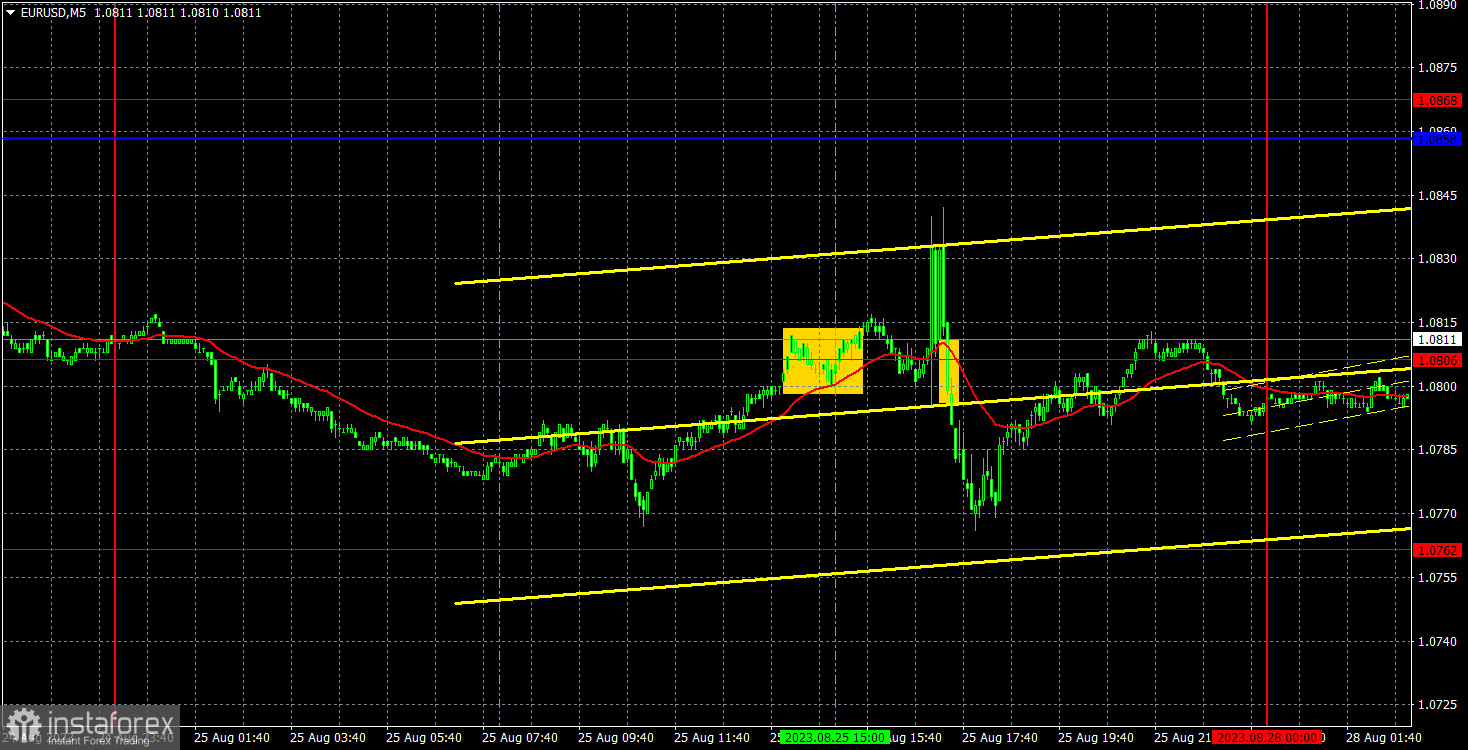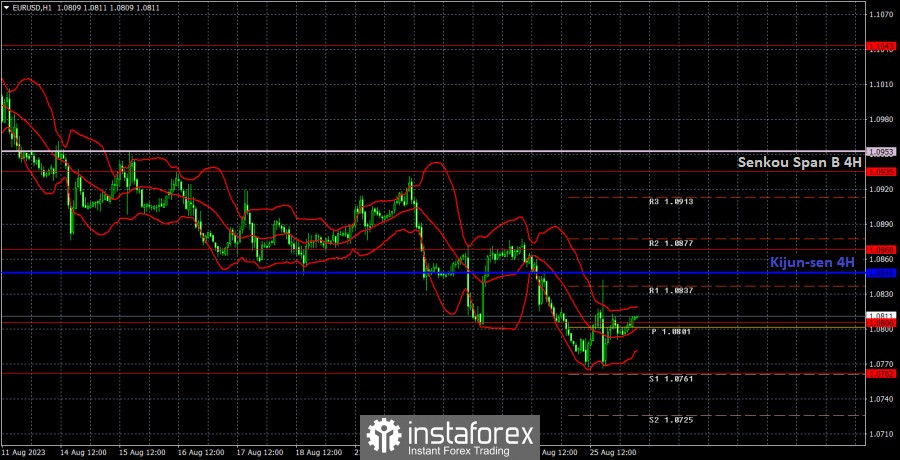Analysis of EUR/USD 5M

Last week, EUR/USD was trading lower again. Even though the euro didn't lose much by the end of the day, traders found a reason to sell the euro and buy the dollar. This fully aligns with our expectations. Take note that the euro had been rising for a long time, and with no good reason. As such, the current decline seems fair and even restores balance in the market. European Central Bank President Christine Lagarde's Friday speech indicated one thing – the ECB is getting closer to taking a pause. However, the ECB rate is only 4.25%, considerably lower than the Federal Reserve's rate. Since the market didn't get the hawkish stance from Lagarde, the single currency didn't rise after her speech. On the other hand, the dollar appreciated following Federal Reserve Chair Jerome Powell's remarks.
Speaking of Friday's trading signals, there isn't much to highlight. The first signal formed at the beginning of the US session, but it also emerged just an hour before Powell's speech. Therefore, we wouldn't recommend taking a risk and entering the market. Although Powell didn't make any amazing statements, his rhetoric can be considered hawkish, and as a result, the US currency appreciated. Another sell signal formed near the 1.0806 level, and it might have been possible to make profit from it by a few dozen points, but we believe this was too risky. However, the sell signal could have been executed, the key was to leave the trade on time.
COT report:

On Friday, a new COT report for August 22 was released. Over the last 11 months, COT reports fully corresponded to what is happening in the market. The chart above clearly shows that the net position of major traders (the second indicator) began to grow in September 2022 and at about the same time the euro started rising too. In the last 6-7 months, the net position has not risen but the euro remains at very high levels. At the moment, the net position of non-commercial traders is bullish and remains strong. The euro keeps climbing against the US dollar (in the long term).
I have already mentioned the fact that a fairly high value of the net position signals the end of an uptrend. This is also confirmed by the first indicator where the red and green lines are very far from each other. Usually, it precedes the end of the trend. During the last reporting week, the number of long positions of the non-commercial group of traders increased by 6,900 and the number of short ones rose by 8,000. The net position decreased by 1,100 contracts, which is not significant. The number of long positions is higher than the number of short ones of non-commercial traders by 160,000. This is a very large gap as the difference is almost threefold. Even without COT reports, it is obvious that the euro should decline but speculators are still in no hurry to sell.
Analysis of EUR/USD 1H

On the 1H chart, the pair continues its gradual yet consistent decline. The euro might start a new correction, but there is no basis for it to enter a sharp uptrend. This week, we are looking forward to several important reports, so the pair's movement will largely depend on their nature. The dollar can easily continue to fall or correct. However, we continue to look only in one direction – downwards.
On August 28, traders should pay attention to the following key levels: 1.0658-1.0669, 1.0762, 1.0806, 1.0868, 1.0935, 1.1043, 1.1092, 1.1137, as well as the Senkou Span B line (1.0953) and the Kijun-sen line (1.0848). The lines of the Ichimoku indicator can move during the day, which should be taken into account when determining trading signals. There are support and resistance levels that can be used to lock in profits. Traders look for signals at rebounds and breakouts. It is recommended to set the Stop Loss orders at the breakeven level when the price moves in the right direction by 15 pips. This will protect against possible losses if the signal turns out to be false.
Today, there's nothing noteworthy about the economic calendar. The only event scheduled for the day is a speech by the Bundesbank's head, Joachim Nagel, but this is hardly significant. Lagarde has already conveyed everything we need to know.
Description of the chart:
Support and resistance levels are thick red lines near which the trend may end. They do not provide trading signals;
The Kijun-sen and Senkou Span B lines are the lines of the Ichimoku indicator, plotted to the 1H timeframe from the 4H one. They provide trading signals;
Extreme levels are thin red lines from which the price bounced earlier. They provide trading signals;
Yellow lines are trend lines, trend channels, and any other technical patterns;
Indicator 1 on the COT charts is the net position size for each category of traders;
Indicator 2 on the COT charts is the net position size for the Non-commercial group.
 English
English 
 Русский
Русский Bahasa Indonesia
Bahasa Indonesia Bahasa Malay
Bahasa Malay ไทย
ไทย Español
Español Deutsch
Deutsch Български
Български Français
Français Tiếng Việt
Tiếng Việt 中文
中文 বাংলা
বাংলা हिन्दी
हिन्दी Čeština
Čeština Українська
Українська Română
Română

